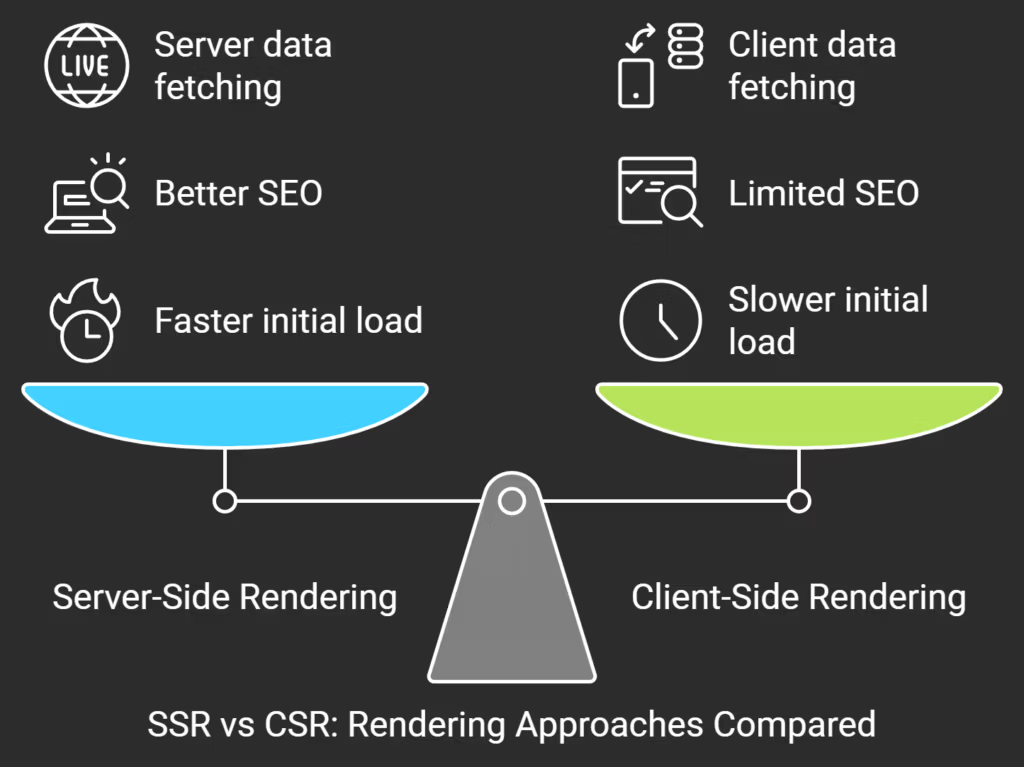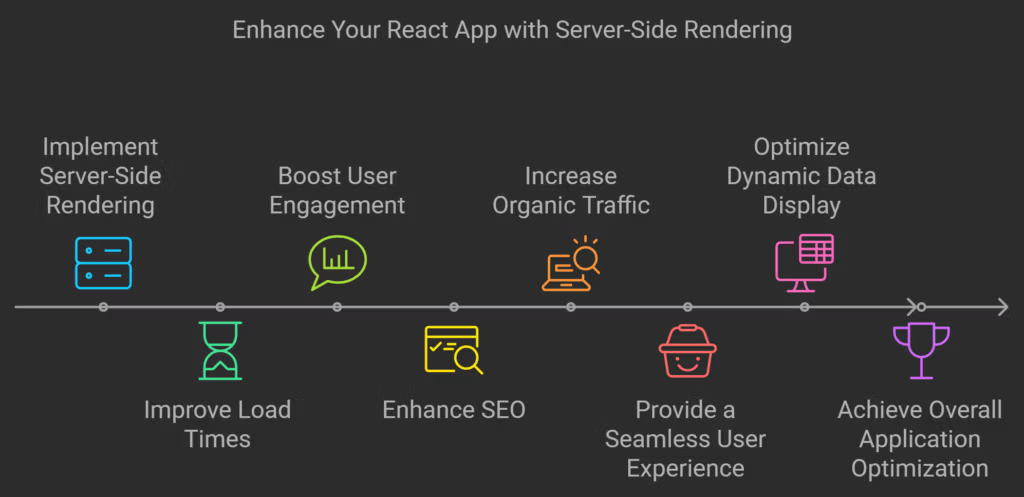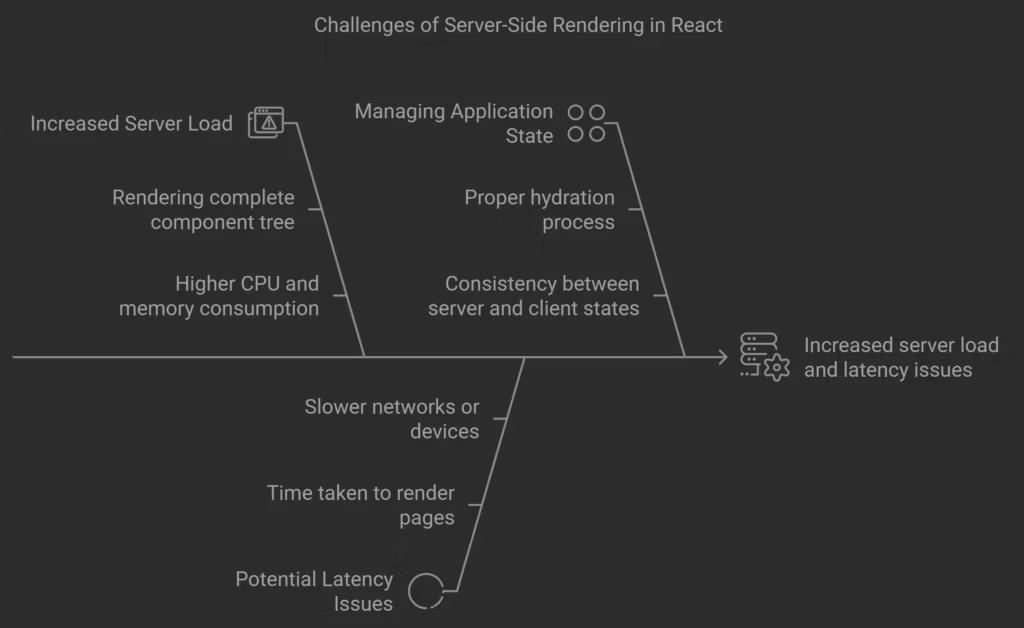
Understanding Server-Side Rendering in React: Benefits and Best Practices
What is Server-Side Rendering (SSR) in React?
Server-Side Rendering (SSR) in React refers to the process of generating HTML content on a server rather than directly in the user’s browser. This method contrasts with traditional client-side rendering, where the browser downloads a minimal HTML page and relies heavily on JavaScript to populate content dynamically. With SSR, the server compiles the application and sends a fully-rendered HTML page to the client. This approach presents several advantages, particularly in enhancing performance and user experience.
When an SSR-enabled React application is accessed, the server handles the initial rendering, producing the complete HTML markup for the requested route. This allows the user to view the rendered content almost instantaneously, as they receive a fully-formed page rather than a blank one while waiting for JavaScript execution. Consequently, this can lead to faster load times, which is particularly important for SEO and user retention. Search engines can quickly index content that is readily available in the HTML, improving the visibility of web applications.
One major distinction between SSR and client-side rendering lies in how each handles data fetching. In SSR, data is fetched on the server before the HTML is rendered, allowing the response to include dynamic data. On the other hand, with client-side rendering, data retrieval and presentation occur after the initial page load, often requiring additional API calls and possibly leading to a delayed display of content. As more developers recognize the potential benefits of SSR—such as improved performance, SEO advantages, and enhanced user experience—it has gained traction for modern web applications, particularly those built with React.

Advantages of Server-Side Rendering
Server-side rendering (SSR) has become an essential technique for developers utilizing React, offering several significant advantages that enhance both performance and user experience. One of the primary benefits of SSR is improved load time. When a web application is rendered on the server, the initial HTML page is delivered to the user much faster than client-side rendering. This rapid delivery minimizes the time users have to wait for content to load, which is critical for retaining visitors and reducing bounce rates. According to studies, reducing load times by just a second can lead to significant increases in user engagement; for example, a one-second delay in load time can cause a 7% decrease in conversions.
Another notable advantage of SSR is its positive impact on search engine optimization (SEO). With traditional client-side rendering, search engine bots sometimes struggle to index content since it is often generated dynamically through JavaScript. With SSR, the server provides a fully rendered HTML page to both users and search engine crawlers, which enhances the visibility of the web application on search engines. Websites using SSR have reported better rankings and increased organic traffic as a result of this improved indexability.
Moreover, SSR can lead to a more seamless user experience. By rendering pages on the server, users benefit from receiving fully-loaded pages without experiencing the visual loading indicators typically associated with client-side fetching. This results in a smoother interaction with the application, as users perceive the site as faster and more responsive. Additionally, SSR can be particularly beneficial for applications that feature dynamic data, as it enables the immediate display of updated information without compromising loading speed.
In summary, the advantages of server-side rendering in React cannot be overstated. From enhancing load times to improving SEO and providing a better user experience, SSR serves as a valuable strategy for developers seeking to optimize their applications effectively.

Implementing Server-Side Rendering in React Applications
Server-side rendering (SSR) has emerged as an essential technique for improving the performance and SEO of React applications. To successfully implement SSR, developers can leverage frameworks and libraries designed specifically for this purpose, with Next.js being one of the most popular choices. Next.js simplifies the SSR process by enabling developers to render React components on the server rather than relying solely on the client, which enhances loading speed and provides better search engine indexing.
Another important tool to consider is React Router, which works seamlessly with SSR to manage navigation within the application. Utilizing these tools allows developers to define routes effectively and manage how components are rendered on both the server and the client side. This dual rendering capability is crucial for ensuring users receive a fully rendered page upon their first visit, thus improving user experience.
When structuring an SSR-enabled application, several best practices should be followed. For instance, organizing the application into distinct layers can enhance maintainability and clarity. Developers should consider implementing a centralized data-fetching strategy, allowing data to be retrieved before the server renders the components. This approach minimizes loading times and ensures users see the necessary information without delay.
Handling state management effectively is also vital in an SSR context. Using libraries such as Redux or Zustand can provide a systematic way to manage application state. Setting up a proper mechanism for state hydration, which allows the server-rendered state to sync with the client’s state upon rehydration, is crucial for maintaining consistency across different user sessions.
In conclusion, implementing server-side rendering in React applications is a powerful way to enhance performance and user experience. By utilizing tools like Next.js and React Router and adhering to best practices for routing, data fetching, and state management, developers can build efficient and scalable React applications.

Challenges and Considerations When Using SSR
While server-side rendering (SSR) in React offers numerous advantages, it also presents certain challenges that developers must navigate. One significant concern is the increased server load that comes with SSR. When a request is made, the server is responsible for rendering the complete React component tree for each user. This can lead to higher CPU and memory consumption, especially during peak traffic, resulting in resource constraints. To mitigate this, developers can implement caching strategies, such as using edge caching or server-side caching with tools like Redis, to reduce the load on the server.
Another challenge associated with SSR is potential latency issues. Since the server must render the page before sending it to the client, the overall time taken to serve the initial request can increase, leading to slower page load times. This can create a negative user experience, particularly on slower networks or devices. Developers should aim to optimize the server’s response time by employing techniques such as code-splitting, dynamic imports, or lazy loading, thereby ensuring that only necessary components are loaded initially. Additionally, using a Content Delivery Network (CDN) can help speed up content delivery by reducing the distance data must travel.

Managing application state in a server-side-rendered React application introduces another layer of complexity. When the server renders the page, it has to account for the current state of the application. Proper hydration—the process of attaching the client-side React to the server-rendered content—needs to be handled carefully to avoid discrepancies between server-rendered and client-rendered states. Utilizing state management libraries like Redux or Context API can help maintain consistency by centralizing the application’s state. Ultimately, while SSR poses certain challenges, developers can successfully implement it by understanding these considerations and employing effective strategies. In summary, with the right planning and optimization, SSR can be advantageous in enhancing user experience while mitigating possible drawbacks.







